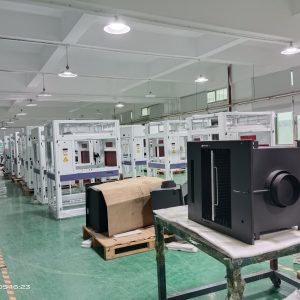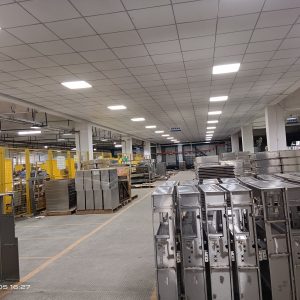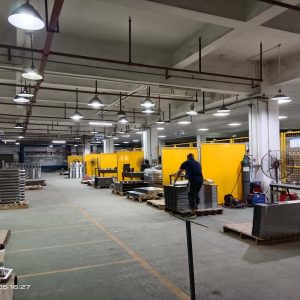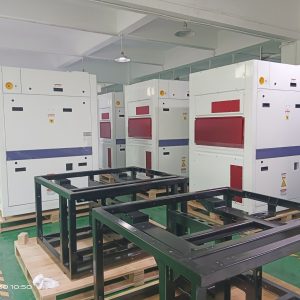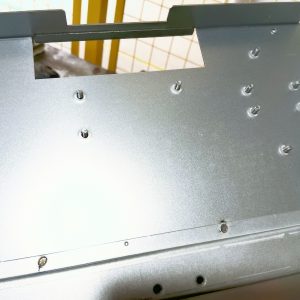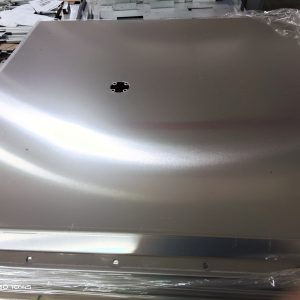The bending radius of sheet metal is a value required in the sheet metal drawing, which is difficult to determine in actual processing. In fact, the bending radius of the sheet metal is related to the material thickness, the pressure of the NC bending machine and the width of the lower die groove of the bending die. What’s the specific relationship? Let’s study it today:
Experience in actual sheet metal processing shows that when the plate thickness is generally no more than 6mm, the inner radius of sheet metal bending can directly use the plate thickness as the radius.
When the plate thickness is greater than 6mm and less than 12mm, the bending radius in the plate is generally 1.25 to 1.5 times of the plate thickness. When the plate thickness is not less than 12mm, the bending radius in the plate is generally 2 to 3 times the plate thickness.
When the bending radius is r = 0.5, the general sheet metal thickness t is equal to 0.5mm. If the radius size larger or smaller than the plate thickness is required, it needs to be processed with a special die.
When the sheet metal drawing requires the sheet metal to be bent by 90 ° and the bending radius is particularly small, the sheet metal should be grooved first and then bent. It can also process special bending machine molds, upper and lower molds.
The bending radius of sheet metal has a certain relationship with the width of the lower die groove of the bending die.
Through a large number of experiments in sheet metal processing, it is found that there is a certain relationship between the groove width of the lower die of the bending die and the bending radius. For example, 1.0mm plate is bent with 8mm groove width, so the bending radius pressed out is R1 ideally.
If the groove width of 20mm is used for bending, because the upper die moves downward during bending, the depth of the stretched plate reaches a certain angle. Then we know that the area of a 20 mm wide groove is larger than that of an 8 mm wide groove. When bending with a 20 mm wide groove, the tensile area becomes larger and the R angle increases.
Therefore, in the case of requiring the bending radius of the plate without damaging the die of the bending machine, we try to bend with a narrow groove. Under normal circumstances, it is recommended to operate according to the standard ratio of plate thickness to slot width of 1:8. The minimum thickness shall not be less than the ratio of 1:6 between the plate thickness and the groove width. The sheet metal bending can be appropriately smaller and shall not be less than the ratio of 1:4 between the plate thickness and the groove width. Suggestion: if the strength allows, the method of grooving first and bending is preferred to make small sheet metal bending radius.
OEM Custom Radiator Support Bracket | Custom Metal Fabrication |Sheet Metal Custom
What points should be paid attention to after the maintenance of hydraulic sheet metal bending machine?
1 commissioning and operation
(1) After the hydraulic sheet metal bending machine is installed and calibrated, it shall be lubricated with lubricating oil to make it fully lubricated.
(2) Check the fastening bolts at the joint for looseness, and fasten them in time if any.
(3) Clean the oil tank and check the filter screen for problems.
(4) Check the electrical parts. If there is any problem, deal with it in time. If there is no problem, you can turn on the power supply, and then start the motor to check whether the steering of the oil pump is correct. If the steering is correct, let it idle for about three minutes.
(5) Check whether the electrical and hydraulic components work normally.
2 maintenance
(1) The oil level of the oil tank shall be checked every week to see whether the oil level is too low and whether the hydraulic oil shall be supplemented.
(2) The system oil temperature shall be controlled within the range of 35 ℃ – 60 ℃. Excessive temperature will damage the parts.
(3) The hydraulic components should be cleaned every month to prevent dirt from entering them.
(4) The bending of each oil pipe shall be checked for deformation and other abnormalities. If any, it shall be replaced immediately.
QUICK LINKS: FAQ | China Sheet Metal | Sheet Metal Enclosure Fabrication | Metal cases Aluminum case suppliers | Sheet Metal Manufacturing | Alu Bracket | Sheet Metal Custom | CNC Stamping Parts | Custom Metal Fabricators Near Me |Metal Frames| Sheet Metal Chassis
